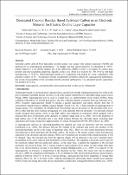Options
Desiccated Coconut Residue Based Activated Carbon as an Electrode Material for Electric Double Layer Capacitor
Journal
Applied Physics Research
Date Issued
2015
Author(s)
Mohd Adib Yahya
C. W. Z. C. W. Ngah
M. A. Hashim
Musa Ahmad
Mohd Ambar Yarmo
DOI
10.5539/apr.v7n2p93
Abstract
Activated carbon derived from desiccated coconut residue was treated with sodium hydroxide (NaOH) and analyzed for its supercapacitor performance. The sample was then characterized by N2 adsorption at -196°C, Energy dispersive x-ray (EDX) analysis and X-ray diffraction (XRD) in order to investigate its surface area, porosity and microcrystalline properties. Specific surface area (SSA) was found to be 1394.79 m2/g with high microporosity of 76.92 %. Electrochemical double-layer capacitance was studied by cyclic voltammetry with potential window of 1V. The presence of high microporosity properties affects the supercapacitor performance due to lack of accessibility of the electrolyte into the activated carbon pores. The calculated specific capacitance was found to be 42 F/g.
Subjects
File(s)
Loading...
Name
Desiccated Coconut Residue Based Activated Carbon as an Electrode Material for Electric Double Layer Capacitor.pdf
Size
329.68 KB
Format
Adobe PDF
Checksum
(MD5):f0390f8c37da46e304a336d2b9ac7e5d